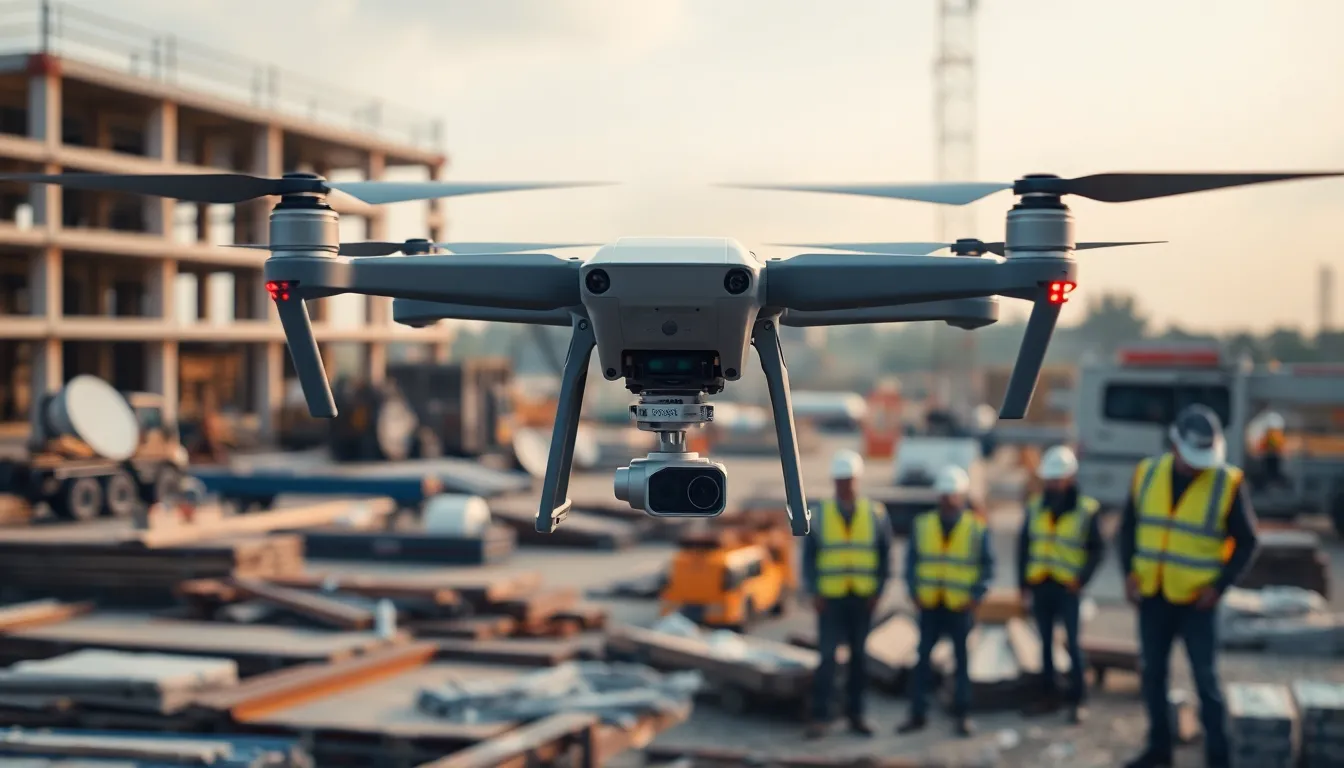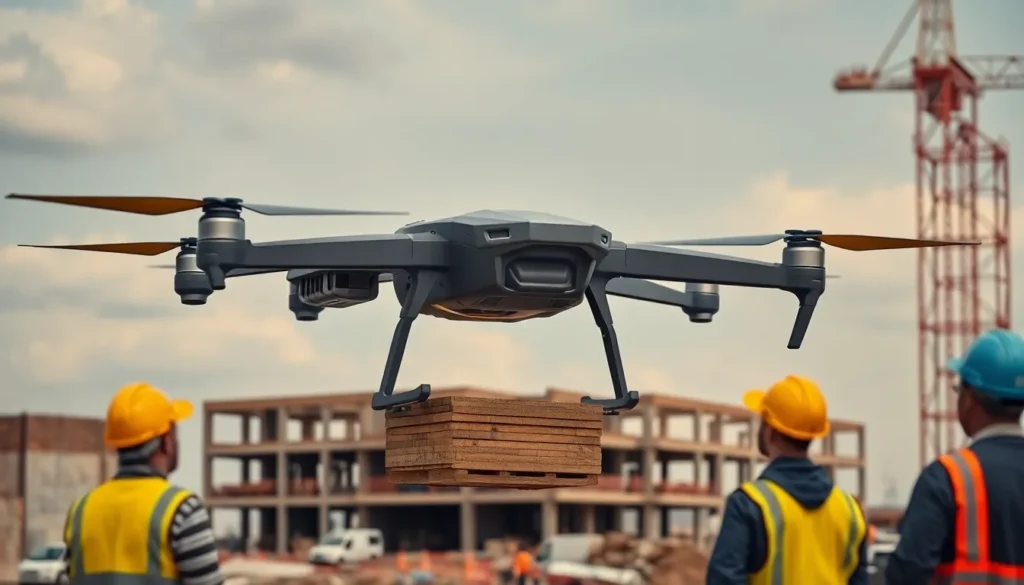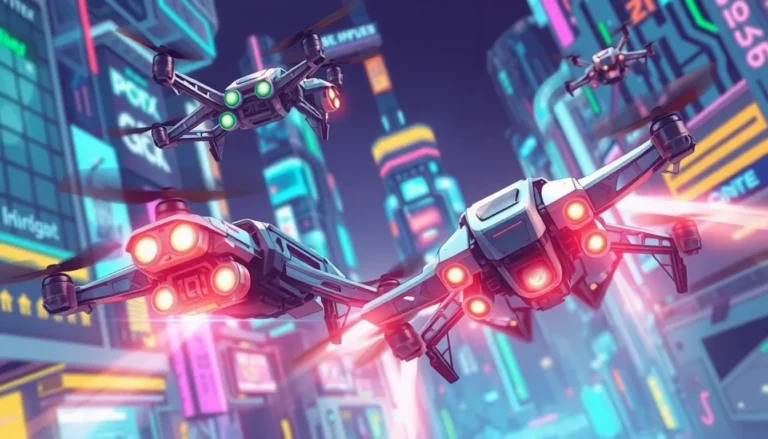Table of Contents
ToggleIn a world where carrying groceries up the stairs feels like an Olympic sport, heavy-lift drones swoop in like superhero sidekicks. These aerial marvels are transforming the way industries handle logistics, construction, and even disaster relief. Imagine a drone so powerful it could haul everything from building materials to medical supplies, all while you kick back and enjoy your favorite show.
Heavy-lift drones aren’t just about muscle; they’re about efficiency, safety, and a sprinkle of futuristic flair. As they take to the skies, they’re redefining what’s possible in transportation and delivery. Whether it’s speeding up supply chains or making hard-to-reach areas accessible, these drones are proving that sometimes, the sky isn’t the limit—it’s just the beginning.
Overview of Heavy-Lift Drones
Heavy-lift drones carry substantial payloads, making them essential in various applications. Designed to handle large cargo volumes, these drones significantly impact logistics by streamlining transportation. In construction, they facilitate the movement of equipment and materials across challenging terrains. Disaster relief operations benefit from their ability to deliver supplies quickly in remote locations.
Most heavy-lift drones operate using advanced technologies, such as electric propulsion systems and automated flight controls. Increased energy efficiency boosts their operational range, allowing them to service more extensive areas without needing frequent recharging. Many models can lift payloads exceeding 400 pounds, demonstrating their versatility in handling diverse tasks.
Specific industries increasingly adopt these drones to improve efficiency. For example, agriculture utilizes heavy-lift drones for seeding and crop monitoring, enhancing productivity. In humanitarian efforts, they transport medical supplies and food to inaccessible regions, making a significant difference during crises.
Safety enhancements come from onboard sensors and real-time data analytics. These features reduce the risk of collision and increase the overall reliability of drone operations. Regulations are evolving to accommodate heavy-lift drones, ensuring integration into national airspace while maintaining safety standards.
Heavy-lift drones are revolutionizing supply chains, enabling businesses to optimize processes. With growing technological advancements, their role in transportation and delivery is expanding. Potential applications continue to emerge, suggesting an exciting future for heavy-lift drones across numerous sectors.
Applications of Heavy-Lift Drones

Heavy-lift drones serve critical functions across various sectors. Their versatility accommodates numerous applications.
Commercial Uses
Heavy-lift drones significantly enhance logistics operations. They transport parcels over long distances, reducing delivery times. Companies in e-commerce utilize these drones to move large packages swiftly and efficiently. Transportation of construction materials also occurs with ease, streamlining projects. Retailers increasingly rely on these drones for inventory management, ensuring efficient stock levels. By incorporating real-time tracking systems, businesses achieve better visibility and control over their supply chains.
Military Uses
The military employs heavy-lift drones for various tactical operations. These aircraft deliver essential supplies and equipment to remote locations. Troops benefit from timely access to food, medical supplies, and ammunition. Surveillance and reconnaissance missions often involve heavy-lift drones, providing real-time data from hard-to-reach areas. By reducing the risks associated with ground transport, these drones enhance mission safety and efficiency. Advancements in drone technology ensure that military applications continue to evolve, meeting the demands of modern warfare.
Industrial Uses
Heavy-lift drones play a pivotal role in industrial applications. They transport equipment and materials on construction sites, enhancing productivity. Mines use these drones to deliver spare parts and supplies to remote locations, minimizing downtime. Utility companies employ them for inspecting and maintaining equipment on power lines and pipelines. In agriculture, heavy-lift drones are instrumental for planting seeds and delivering fertilizers. Efficient data collection also occurs through aerial surveillance, facilitating improved resource management across various industries.
Key Features of Heavy-Lift Drones
Heavy-lift drones feature several critical attributes that make them indispensable across numerous industries. Their unique specifications optimize performance and enhance operational efficiency.
Payload Capacity
Payload capacity in heavy-lift drones typically exceeds 400 pounds. This significant capability enables these drones to transport large equipment, materials, and supplies efficiently. For instance, in construction, they are responsible for moving tools and heavy materials to elevated work sites. Agriculture benefits from their ability to carry multiple tons of seeds and fertilizer simultaneously, supporting crop production schedules. Additionally, humanitarian efforts utilize their payload capabilities for delivering food, medical supplies, and relief kits to remote areas.
Flight Duration
Flight duration plays a critical role in operational effectiveness. Heavy-lift drones can achieve flight times ranging from 30 minutes to several hours, depending on several factors such as payload weight and battery capacity. Longer flight durations facilitate more comprehensive coverage of delivery routes, which enhances logistics performance. For example, drones that can fly for two hours allow for expansive coverage of rural regions in agricultural applications. Extended flight capabilities also enable consistent surveillance, improving mission safety in military operations.
Design and Build
Design and build characteristics contribute to overall durability and functionality. Most heavy-lift drones feature robust frames crafted from materials like carbon fiber or aluminum, ensuring resilience against environmental stress. Modular designs allow for easy maintenance and upgrades as technology evolves. Many include redundant systems, such as dual batteries or dual propulsion units, which increase reliability during flight. Enhanced aerodynamics leads to improved energy efficiency, allowing drones to carry heavy loads over significant distances without excessive power consumption. These design features enhance their versatility across various operational environments.
Leading Brands in Heavy-Lift Drones
Several prominent brands lead the market in heavy-lift drones. These companies focus on innovation and reliability, driving advancements in various sectors.
Brand A
DJI is a dominant player in the drone industry. Their Matrice 600 series supports a payload capacity of 6 kilograms, catering to professional filmmakers and industrial applications. A unique feature includes its modular design, which allows for customization based on user needs. The drones utilize advanced flight stabilization technology, ensuring smooth operation even in challenging conditions. Notably, DJI’s drones integrate seamlessly with high-definition imaging systems, enhancing data collection opportunities in agriculture and surveying.
Brand B
Amazon Prime Air represents another key player in the heavy-lift drone market. This service aims to revolutionize package delivery with its innovative design. Amazon’s delivery drones feature a payload capacity of up to 5 kilograms, ideal for quick delivery of consumer goods. Equipped with sophisticated navigation systems, they can efficiently navigate urban landscapes. The potential to reduce delivery times significantly positions Amazon as a leader in logistics. Additionally, their commitment to safety includes redundant control systems, ensuring reliable operation during transit.
Advantages of Heavy-Lift Drones
Heavy-lift drones offer numerous benefits across various industries, significantly impacting logistics, construction, and humanitarian efforts.
Efficiency
Efficiency stands out as a primary advantage of heavy-lift drones. These drones transport large cargo volumes swiftly, reducing the time needed to move goods. With payload capacities over 400 pounds, they eliminate the need for multiple trips, enhancing overall productivity. Automated flight controls and advanced navigation systems enable precise deliveries, even to hard-to-reach areas. Industries such as agriculture increasingly rely on these drones for tasks that require rapid deployment of supplies. Real-time data analytics improve routing and safety, mitigating the chances of collisions and ensuring timely operations.
Cost-Effectiveness
Cost-effectiveness emerges as another critical advantage of heavy-lift drones. Their ability to carry substantial payloads reduces transportation costs, minimizing the reliance on traditional vehicles. Organizations experience savings with fewer crew members required for logistics operations. Maintenance costs remain low due to robust designs and technologies employed in these drones. Investing in heavy-lift drones fosters long-term financial benefits, especially in industries like construction, where they streamline material handling. The reduced need for ground transport also translates to lower fuel consumption and fewer emissions, contributing to sustainability goals while boosting operational savings.
Challenges and Limitations
Heavy-lift drones face notable challenges that can impact their widespread adoption and functionality.
Regulatory Issues
Regulatory frameworks lag behind the rapid development of heavy-lift drones. Many countries lack established guidelines for their operation, especially in urban environments where safety concerns arise. Compliance with airspace management systems poses another hurdle, as drone operators must navigate existing aviation regulations effectively. Air traffic control integration is crucial, yet many regions remain under-regulated, complicating commercial use. Restrictions on low-altitude flight zones and privacy concerns hinder operational flexibility. Addressing these regulatory gaps will require collaboration between lawmakers, industry stakeholders, and safety organizations to establish a comprehensive and adaptable framework.
Technical Challenges
Technical challenges significantly affect heavy-lift drone capabilities. Payload weight impacts flight stability and performance, necessitating advanced engineering solutions for improved durability. Battery life presents another limitation, as current technologies often struggle to support extended flight durations while carrying heavy loads. The complexity of navigation systems can lead to errors in varied environments, especially in challenging weather conditions. Reliability of sensors and data processing systems influences operational safety, requiring continuous improvement. Emerging technologies must focus on addressing these technical issues to enhance performance and broaden application scopes across industries.
Heavy-lift drones are poised to reshape various industries by enhancing logistics and operational efficiency. Their ability to transport large payloads quickly and safely offers significant advantages in sectors like construction and disaster relief. As technology advances and regulations evolve, these drones will likely become even more integral to supply chains and emergency response efforts.
The ongoing development of heavy-lift drones promises exciting innovations that could further expand their applications. With their potential to improve productivity and reduce costs, they represent a transformative force in modern transportation. The future of heavy-lift drones is bright as they continue to break barriers and redefine what’s possible in aerial logistics.







